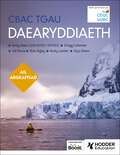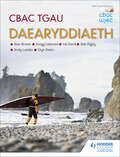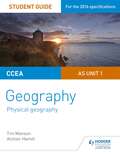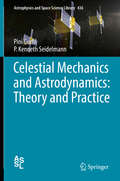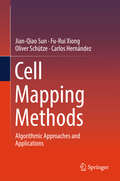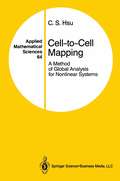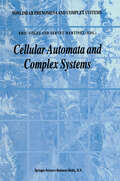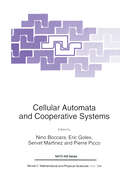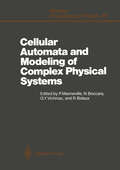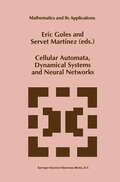- Table View
- List View
CBAC TGAU Daearyddiaeth Ail Argraffiad (WJEC GCSE Geography Second Edition Welsh-language edition)
by Andy Owen Gregg Coleman Val Davis Bob Digby Andy Leeder Glyn OwenDevelop students' subject knowledge and skills. This fully revised edition features updated case studies, practice questions and clear presentation of key terms.> Contains coherent coverage of every core and optional theme in a single volume, with clear explanations of key concepts throughout> Engages and challenges students with an exciting, thematic approach, brought to life by Welsh, UK and international place references> Improves students' ability to interpret, analyse and evaluate geographical information through practical, skills-focused activities that involve data, maps and photographs> Boosts students' confidence approaching examination by providing extensive practice questions for each assessed themeThis book also includes coverage of the Eduqas GCSE Geography A specification.Please note: This is a Welsh language edition.
CBAC TGAU Daearyddiaeth (WJEC GCSE Geography Welsh-language edition)
by Andy Leeder Alan Brown Gregg Coleman Bob Digby Glyn Owen Val DavisEndorsed by WJECDevelop your students' subject knowledge and skills using in-depth topic coverage and developmental activities to create your own teaching pathway through the core and optional content in the 2016 specifications, with support at every stage from the authors of the bestselling WJEC Student Book.- Contains coherent coverage of every core and optional theme in a single volume, with clear explanations of key concepts throughout- Engages and challenges students of all abilities with an exciting, thematic approach, brought to life by Welsh, UK and international place references- Improves students' ability to interpret, analyse and evaluate geographical information through practical, skills-focused activities that involve data, maps and photographs- Boosts candidates' confidence approaching examination by providing numerous learning opportunities for each assessed theme- Enables effective differentiation with enquiry tasks designed to stretch higher-ability students and encourage independent research- Includes trusted guidance from the Field Studies Council on suggested human and physical fieldwork projects and methodologies, making it easier to address the revised fieldwork criteriaThis is a Welsh-language edition.
CCEA A-level Geography Student Guide 2: AS Unit 2 (PDF)
by Tim MansonReinforce students' geographical understanding throughout their course; clear topic summaries with sample questions and answers help students improve their exam technique and achieve their best.Written by a teacher with extensive examining experience, this guide:- Helps students identify what they need to know with a concise summary of the topics examined at AS and A-level- Consolidates understanding through assessment tips and knowledge-check questions- Offers opportunities for students to improve their exam technique by consulting sample graded answers to exam-style questions- Develops independent learning and research skills- Provides the content students need to produce their own revision notes
CCEA A-level Geography Student Guide 3: AS Unit 3/A2 Unit 3 (PDF)
by Tim MansonReinforce students' geographical understanding throughout their course; clear topic summaries with sample questions and answers help students improve their exam technique and achieve their best.Written by a teacher with extensive examining experience, this guide:- Helps students identify what they need to know with a concise summary of the topics examined at AS and A-level- Consolidates understanding through assessment tips and knowledge-check questions- Offers opportunities for students to improve their exam technique by consulting sample graded answers to exam-style questions- Develops independent learning and research skills- Provides the content students need to produce their own revision notes
CCEA A-level Geography Student Guide 4: A2 Unit 1 (PDF)
by Tim Manson Alistair HamillReinforce students' geographical understanding throughout their course; clear topic summaries with sample questions and answers help students improve their exam technique and achieve their best.Written by teachers with extensive examining experience, this guide:- Helps students identify what they need to know with a concise summary of the topics examined at AS and A-level- Consolidates understanding through assessment tips and knowledge-check questions- Offers opportunities for students to improve their exam technique by consulting sample graded answers to exam-style questions- Develops independent learning and research skills- Provides the content students need to produce their own revision notes
CCEA A-level Geography Student Guide 5: A2 Unit 2 (PDF)
by Tim MansonReinforce students' geographical understanding throughout their course; clear topic summaries with sample questions and answers help students improve their exam technique and achieve their best.Written by a teacher with extensive examining experience, this guide:- Helps students identify what they need to know with a concise summary of the topics examined at AS and A-level- Consolidates understanding through assessment tips and knowledge-check questions- Offers opportunities for students to improve their exam technique by consulting sample graded answers to exam-style questions- Develops independent learning and research skills- Provides the content students need to produce their own revision notes
CCEA AS Unit 1 Geography Student Guide 1: Physical Geography
by Tim Manson Alistair HamillReinforce students' geographical understanding throughout their course; clear topic summaries with sample questions and answers help students improve their exam technique and achieve their best.
CCEA GCSE Geography (3rd Edition) (PDF)
by Petula Henderson Stephen RoulstonConfidently navigate the new content and assessment requirements with a fully updated edition of the longest-standing Student Book for CCEA GCSE Geography, trusted for over a decade to help thousands of students succeed.- Provides complete coverage of the specification with clear, detailed explanations of each unit and theme, plus a dedicated chapter on fieldwork- Develops students' knowledge and skills through activities that involve interpreting, analysing and evaluating geographical information and activities that focus on practising key skills- Brings concepts to life through diagrams, maps, photographs and a rich bank of up-to-date case study material- Enables high achievers to extend their knowledge and fulfil their potential by including research activities that go beyond the core content- Prepares students for the non-tiered examinations with exam-style questions for each theme, tips and guidance from experienced examiners, plus answers and mark schemes available online in the free Teaching & Learning Resources
CCEA GCSE Geography Study Guide Unit 1: Understanding Our Natural World
by Tim MansonThis essential study guide addresses Unit 1 of the CCEA GCSE Geography specification – Understanding our Natural World. Written by Tim Manson, an experienced teacher, examiner and author, the book guides students through the course, the case studies and the key geographical terms. It checks knowledge and understanding with numerous questions; aids revision with advice and tips; and prepares students for assessment with exam-style practice questions and graded student answers. It has also undergone a meticulous quality assurance process by an expert in the CCEA specification, making it an invaluable resource for all students studying GCSE Geography. Contents: How to use this book Study Material: Theme A: River Environments Theme B: Coastal Environments Theme C: Our Changing Weather and Climate Theme D: The Restless Earth Practice Questions: Getting the Best Grade Possible Theme A: River Environments Theme B: Coastal Environments Theme C: Our Changing Weather and Climate Theme D: The Restless Earth Revision Advice Glossary
Celebrating Soil: Discovering Soils and Landscapes
by M.R. Balks D. ZabowskiThis richly illustrated book celebrates the diversity, importance, and intrinsic beauty of soils around the world and helps the reader to understand the ways that soils are related to the landscapes in which they form. The book unravels the complex bond between humans and soils and the importance of soils in our cultures and everyday lives.Soil is critical to terrestrial life on earth. It underpins human food supply and provides materials on which we build our lives. Soil is out of sight and often out of mind, thus easy to overlook. Yet soil has tremendous variety and intrinsic beauty for those who care to look. Soil contains a memory of the events that have shaped the landscape and the environment. With help you can look at a soil and understand the stories that it has to tell. Written in a reader-friendly way, Celebrating Soil is a wonderful resource for farmers, horticulturalists, naturalists, students and others who are concerned about how soils are formed, work and are used.
Celebrating the International Year of Mineralogy: Progress and Landmark Discoveries of the Last Decades (Springer Mineralogy)
by Luca Bindi Giuseppe CrucianiThis volume celebrates mineral sciences and what are considered the most important progresses and breakthroughs in this discipline. Authoritative authors, who, in most cases, are the direct discoverers recount the steps of their research, which represent landmark developments of mineralogy and mineralogical crystallography.
A Celebration of Mathematical Modeling: The Joseph B. Keller Anniversary Volume
by Dan Czamanski Marcus J. Grote George PapanicolaouThisvolumecelebratestheeightiethbirthdayofJosephB. Keller. The authors who contributed to this volume belong to what can be called the “Keller school of applied mathematics. ” They are former students, postdoctoral fellows and visiting scientists who have collaborated with Joe (some of them still do) during his long career. They all look at Joe as their ultimate (role) model. JoeKeller’sdistinguishedcareerhasbeendividedbetweentheCourant Institute of Mathematical Sciences at New York University, where he received all his degrees (his PhD adviser being the great R. Courant himself) and served as a professor for 30 years, and Stanford University, where he has been since 1978. The appended photos highlight some scenes from the old days. Those who know Joe Keller’s work have been always amazed by its diversity and breadth. It is considered a well-known truth that there is not a single important area in applied mathematics or physics which Keller did not contribute to. This can be appreciated, for example, by glancing through his list of publication included in this volume. App- priately, the papers in this book, written with Joe’s inspiration, cover a variety of application areas; together they span the broad subject of mathematical modeling. The models discussed in the book describe the behavior of various systems such as those related to ?nance, waves, - croorganisms, shocks, DNA, ?ames, contact, optics, ?uids, bubbles and jets. Joe’s activity includes many more areas, which unfortunately are not represented here.
Celebrity Advocacy and International Development (Rethinking Development)
by Dan BrockingtonCelebrity advocacy is a curious phenomenon. It occupies a significant proportion of the public domain, but does so without engaging particularly well with much of the public. Yet this may not matter very much. Many people at the core of advocacy, and in political and business elites, simply do not notice any lack of engagement. In these circles celebrity advocacy can be remarkably effective. Celebrity Advocacy and International Development examines the work of celebrity advocacy and lobbying in international development. Its purpose is to understand the alliances resulting, their history, consequences, wider contexts and implications. It argues that celebrity advocacy signals a new aspect of elite rule. For populist celebrity advocacy can mark, ironically, a disengagement between the public and politics, and particularly the public and civil society. Recognising this poses new challenges, but also presents new opportunities, for the development movement. This book gives students and researchers in development studies and media studies a wealth of original empirical data, including interviews across the NGO sector, media and celebrity industries, newspaper analysis, large surveys of public opinion, and focus group research.
Celebrity Advocacy and International Development (Rethinking Development)
by Dan BrockingtonCelebrity advocacy is a curious phenomenon. It occupies a significant proportion of the public domain, but does so without engaging particularly well with much of the public. Yet this may not matter very much. Many people at the core of advocacy, and in political and business elites, simply do not notice any lack of engagement. In these circles celebrity advocacy can be remarkably effective. Celebrity Advocacy and International Development examines the work of celebrity advocacy and lobbying in international development. Its purpose is to understand the alliances resulting, their history, consequences, wider contexts and implications. It argues that celebrity advocacy signals a new aspect of elite rule. For populist celebrity advocacy can mark, ironically, a disengagement between the public and politics, and particularly the public and civil society. Recognising this poses new challenges, but also presents new opportunities, for the development movement. This book gives students and researchers in development studies and media studies a wealth of original empirical data, including interviews across the NGO sector, media and celebrity industries, newspaper analysis, large surveys of public opinion, and focus group research.
Celebrity Humanitarianism and North-South Relations: Politics, place and power (Rethinking Development)
by Lisa Ann RicheyDiscussion over celebrity engagement is often limited to theoretical critique or normative name-calling, without much grounded research into what it is that celebrities are doing, the same or differently throughout the world. Crucially, little attention has been paid to the Global South, either as a place where celebrities intervene into existing politics and social processes, or as the generator of Southern celebrities engaged in ‘do-gooding’. This book examines what the diverse roster of celebrity humanitarians are actually doing in and across North and South contexts. Celebrity humanitarianism is an effective lens for viewing the multiple and diverse relationships that constitute the links between North and South. New empirical findings on celebrity humanitarianism on the ground in Thailand, Malawi, Bangladesh, South Africa, China, Haiti, Congo, US, Denmark and Australia illustrate the impact of celebrity humanitarianism in the Global South and celebritization, participation and democratization in the donor North. By investigating one of the most mediatized and distant representations of humanitarianism (the celebrity intervention) from a perspective of contextualization, the book underscores the importance of context in international development. This book will be of interest to students and researchers in the fields of development studies, celebrity studies, anthropology, political science, geography, and related disciplines. It is also of great relevance to development practitioners, humanitarian NGOs, and professionals in business (CSR, fair trade) who work in the increasingly celebritized field.
Celebrity Humanitarianism and North-South Relations: Politics, place and power (Rethinking Development)
by Lisa Ann RicheyDiscussion over celebrity engagement is often limited to theoretical critique or normative name-calling, without much grounded research into what it is that celebrities are doing, the same or differently throughout the world. Crucially, little attention has been paid to the Global South, either as a place where celebrities intervene into existing politics and social processes, or as the generator of Southern celebrities engaged in ‘do-gooding’. This book examines what the diverse roster of celebrity humanitarians are actually doing in and across North and South contexts. Celebrity humanitarianism is an effective lens for viewing the multiple and diverse relationships that constitute the links between North and South. New empirical findings on celebrity humanitarianism on the ground in Thailand, Malawi, Bangladesh, South Africa, China, Haiti, Congo, US, Denmark and Australia illustrate the impact of celebrity humanitarianism in the Global South and celebritization, participation and democratization in the donor North. By investigating one of the most mediatized and distant representations of humanitarianism (the celebrity intervention) from a perspective of contextualization, the book underscores the importance of context in international development. This book will be of interest to students and researchers in the fields of development studies, celebrity studies, anthropology, political science, geography, and related disciplines. It is also of great relevance to development practitioners, humanitarian NGOs, and professionals in business (CSR, fair trade) who work in the increasingly celebritized field.
Celestial Mechanics and Astrodynamics: Theory and Practice (Astrophysics and Space Science Library #436)
by Pini Gurfil P. Kenneth SeidelmannThis volume is designed as an introductory text and reference book for graduate students, researchers and practitioners in the fields of astronomy, astrodynamics, satellite systems, space sciences and astrophysics. The purpose of the book is to emphasize the similarities between celestial mechanics and astrodynamics, and to present recent advances in these two fields so that the reader can understand the inter-relations and mutual influences. The juxtaposition of celestial mechanics and astrodynamics is a unique approach that is expected to be a refreshing attempt to discuss both the mechanics of space flight and the dynamics of celestial objects. “Celestial Mechanics and Astrodynamics: Theory and Practice” also presents the main challenges and future prospects for the two fields in an elaborate, comprehensive and rigorous manner. The book presents homogenous and fluent discussions of the key problems, rendering a portrayal of recent advances in the field together with some basic concepts and essential infrastructure in orbital mechanics. The text contains introductory material followed by a gradual development of ideas interweaved to yield a coherent presentation of advanced topics.
Celestial Shadows: Eclipses, Transits, and Occultations (Astrophysics and Space Science Library #410)
by John Westfall William SheehanMuch of what is known about the universe came from the study of celestial shadows. This book looks in detail at the way eclipses and other celestial shadows have given us amazing insights into the nature of the objects in our solar system and how they are even helping us discover and analyze planets that orbit stars other than our Sun. A variety of eclipses, transits, and occultations of the mooons of Jupiter and Saturn, Pluto and its satellite Charon, asteroids and stars have helped astronomers to work out their dimensions, structures, and shapes - even the existence of atmospheres and structures of exoplanets.Long before Columbus set out to reach the Far East by sailing West, the curved shadow of the Earth on the Moon during a lunar eclipse revealed that we inhabit a round world, a globe. More recently, comparisons of the sunlit and Earthlit parts of the Moon have been used to determine changes in the Earth's brightness as a way of monitoring possible effects in cloud coverage which may be related to global warming. Shadows were used by the Greek mathematician Eratosthenes to work out the first estimate of the circumference of the Earth, by Galileo to measure the heights of the lunar mountains and by eighteenth century astronomers to determine the scale of the Solar System itself. Some of the rarest and most wonderful shadows of all are those cast onto Earth by the lovely "Evening Star" Venus as it goes between the Earth and the Sun. These majestic transits of Venus occur at most two in a century; after the 2012 transit, there is not a chance to observe this phenomenon until 2117, while the more common sweep of a total solar eclipse creates one of the most dramatic and awe-inspiring events of nature. Though it may have once been a source of consternation or dread, solar eclipses now lead thousands of amateur astronomers and "eclipse-chasers" to travel the globe in order to experience the dramatic view under "totality." These phenomena are among the most spectacular available to observers and are given their full due in Westfall and Sheehan's comprehensive study.
Cell Mapping Methods: Algorithmic Approaches and Applications (Nonlinear Systems And Complexity Ser. #99)
by Jian-Qiao Sun Fu-Rui Xiong Oliver Schütze Carlos HernándezThis book presents the latest algorithmic developments in the cell-mapping method for the global analysis of nonlinear dynamic systems, global solutions for multi-objective optimization problems, and global solutions for zeros of complex algebraic equations. It also discusses related engineering and scientific applications, including the nonlinear design of structures for better vibration resistance and reliability; multi-objective, structural-acoustic design for sound abatement; optimal multi-objective design of airfoils for better lift; and optimal multi-objective design of linear and nonlinear controls with or without time delay.The first book on the subject to include extensive Matlab and C++ codes, it presents various implementation algorithms of the cell-mapping method, enabling readers to understand how the method works and its programming aspects. A link to the codes on the Springer website will be provided to the readers.
The Cell Method for Electrical Engineering and Multiphysics Problems: An Introduction (Lecture Notes in Electrical Engineering #230)
by Piergiorgio Alotto Fabio Freschi Maurizio Repetto Carlo RossoThis book presents a numerical scheme for the solution of field problems governed by partial differential equations: the cell method. The technique lends itself naturally to the solution of multiphysics problems with several interacting phenomena. The Cell Method, based on a space-time tessellation, is intimately related to the work of Tonti and to his ideas of classification diagrams or, as they are nowadays called, Tonti diagrams: a graphical representation of the problem's equations made possible by a suitable selection of a space-time framework relating physical variables to each other. The main features of the cell method are presented and links with many other discrete numerical methods (finite integration techniques, finite difference time domain, finite volumes, mimetic finite differences, etc.) are discussed. After outlining the theoretical basis of the method, a set of physical problems which have been solved with the cell method is described. These single and multiphysics problems stem from the authors' research experience in the fields of electromagnetism, elasticity, thermo-elasticity and others. Finally, the implementation of the numerical technique is described in all its main components: space-time discretization, problem formulation, solution and representation of the resulting physical fields.
Cell-to-Cell Mapping: A Method of Global Analysis for Nonlinear Systems (Applied Mathematical Sciences #64)
by C.S. HsuFor many years, I have been interested in global analysis of nonlinear systems. The original interest stemmed from the study of snap-through stability and jump phenomena in structures. For systems of this kind, where there exist multiple stable equilibrium states or periodic motions, it is important to examine the domains of attraction of these responses in the state space. It was through work in this direction that the cell-to-cell mapping methods were introduced. These methods have received considerable development in the last few years, and have also been applied to some concrete problems. The results look very encouraging and promising. However, up to now, the effort of developing these methods has been by a very small number of people. There was, therefore, a suggestion that the published material, scattered now in various journal articles, could perhaps be pulled together into book form, thus making it more readily available to the general audience in the field of nonlinear oscillations and nonlinear dynamical systems. Conceivably, this might facilitate getting more people interested in working on this topic. On the other hand, there is always a question as to whether a topic (a) holds enough promise for the future, and (b) has gained enough maturity to be put into book form. With regard to (a), only the future will tell. With regard to (b), I believe that, from the point of view of both foundation and methodology, the methods are far from mature.
Cellular Automata and Complex Systems (Nonlinear Phenomena and Complex Systems #3)
by E. Goles Servet MartínezThis book contains the courses given at the Fifth School on Complex Systems held at Santiago, Chile, from 9th .to 13th December 1996. At this school met researchers working on areas related with recent trends in Complex Systems, which include dynamical systems, cellular automata, symbolic dynamics, spatial systems, statistical physics and thermodynamics. Scientists working in these subjects come from several areas: pure and applied mathematics, physics, biology, computer science and electrical engineering. Each contribution is devoted to one of the above subjects. In most cases they are structured as surveys, presenting at the same time an original point of view about the topic and showing mostly new results. The paper of Bruno Durand presents the state of the art on the relationships between the notions of surjectivity, injectivity and reversibility in cellular automata when finite, infinite or periodic configurations are considered, also he discusses decidability problems related with the classification of cellular automata as well as global properties mentioned above. The paper of Eric Goles and Martin Matamala gives a uniform presentation of simulations of Turing machines by cellular automata. The main ingredient is the encoding function which must be fixed for all Turing machine. In this context known results are revised and new results are presented.
Cellular Automata and Cooperative Systems (Nato Science Series C: #396)
by N. Boccara E. Goles Servet Martínez Pierre PiccoCellular Automata and Modeling of Complex Physical Systems: Proceedings of the Winter School, Les Houches, France, February 21–28, 1989 (Springer Proceedings in Physics #46)
by Paul Manneville Nino Boccara Gerard Y. Vichniac Roger BidauxCellular automata are fully discrete dynamical systems with dynamical variables defined at the nodes of a lattice and taking values in a finite set. Application of a local transition rule at each lattice site generates the dynamics. The interpretation of systems with a large number of degrees of freedom in terms of lattice gases has received considerable attention recently due to the many applications of this approach, e.g. for simulating fluid flows under nearly realistic conditions, for modeling complex microscopic natural phenomena such as diffusion-reaction or catalysis, and for analysis of pattern-forming systems. The discussion in this book covers aspects of cellular automata theory related to general problems of information theory and statistical physics, lattice gas theory, direct applications, problems arising in the modeling of microscopic physical processes, complex macroscopic behavior (mostly in connection with turbulence), and the design of special-purpose computers.
Cellular Automata, Dynamical Systems and Neural Networks (Mathematics and Its Applications #282)
by E. Goles Servet MartínezThis book contains the courses given at the Third School on Statistical Physics and Cooperative Systems held at Santiago, Chile, from 14th to 18th December 1992. The main idea of this periodic school was to bring together scientists work with recent trends in Statistical Physics. More precisely ing on subjects related related with non linear phenomena, dynamical systems, ergodic theory, cellular au tomata, symbolic dynamics, large deviation theory and neural networks. Scientists working in these subjects come from several areas: mathematics, biology, physics, computer science, electrical engineering and artificial intelligence. Recently, a very important cross-fertilization has taken place with regard to the aforesaid scientific and technological disciplines, so as to give a new approach to the research whose common core remains in statistical physics. Each contribution is devoted to one or more of the previous subjects. In most cases they are structured as surveys, presenting at the same time an original point of view about the topic and showing mostly new results. The expository text of Fran
